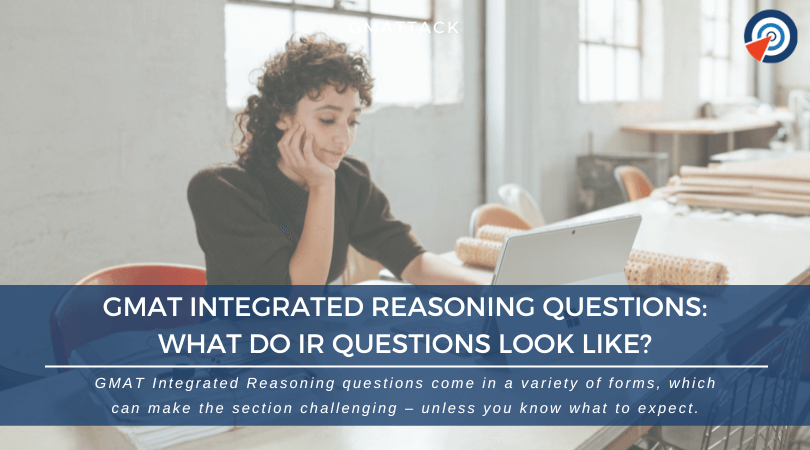GMAT Integrated Reasoning questions come in a variety of forms, and it’s this variety and the general lack of knowledge surrounding the marking criteria that can make the section so challenging – and so daunting for candidates preparing for it.
However, the good news is that there’s a lot of overlap between the Integrated Reasoning section of the GMAT and the main sections of that test. Both Quant and Verbal Reasoning factor into the IR section, so if you’re studying for those (and you should be) then you’re studying for Integrated Reasoning.
Another important factor in preparing for the IR section is understanding what IR questions look like. By studying the various question formats and preparing for them, you will increase your chances of acing the section.
And that’s what this article is about. During the course of this article, we plan to explore what IR questions look like and how best to tackle them.
For further information on the IR section and the best preparation strategies, check out our other IR in-depth articles.
Table of Contents
What is the Format of the IR Section of the GMAT?
The Integrated Reasoning Section of the GMAT has a total of 12 questions, and you are given 30 minutes in which to complete them. While this sounds straightforward, the reality is a little more complicated.
Although there are 12 main questions in the section, these questions may be divided into several sub-questions – sometimes as many as three. What this means is that you will likely be answering many more questions than 12, and with only 30 minutes to do so. Time management, then, is key in the IR section of the GMAT.
To Which Sections of the Main GMAT is the IR Similar?
Certain questions found in the Integrated Reasoning section are very similar to those found in two parts of the main GMAT: Quantitative and Verbal Reasoning. This means, then, that both mathematical and reading comprehension skills are important to the Integrated Reasoning section. A sound grasp of logic is also very useful in this section.
Is the IR Score Factored into the Main GMAT Score?
No. The IR section has its own discrete score, marked out of 12. The main GMAT score is from 200-800, and does not take into account either the Integrated Reasoning or Analytical Writing Assessment sections.
What are the Types of Questions in the Integrated Reasoning Section?
There are four kinds of questions you might come across in the IR section of the GMAT. Let’s take an in-depth look at each kind.
GMAT Integrated Reasoning Questions: Graphics Interpretation
In Graphics Interpretation questions, you will be presented with some kind of graphic (such as a table or chart) containing a variety of data, along with an accompanying text that introduces or contextualizes the graphic. You will then be given several incomplete statements, along with a drop-down box with several values. You must choose the value that best completes the statement, according to the data provided in the graphic.
Sample Graphics Interpretation Question
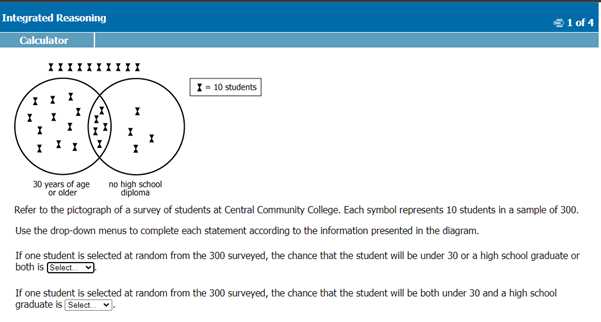
Source: https://www.mba.com/service/samples/sample-275
As we can see in this GMAT Integrated Reading question example, the graphic is a Venn diagram with several legends that represent 10 students each. The diagram is accompanied by explanatory text that gives us the context of the diagram – a survey of students attending a community college.
In the practice statements given, there are four options given in the drop-down box for each statement.
Tips for Answering Graphics Interpretation Questions
- In the run-up to your test, make sure that you familiarize yourself thoroughly with graphics of all types: Venn diagrams (as in the above example), pie charts, bar graphs, scatter graphs and tables are all a possibility in this section, so try to incorporate publications that make use of these into your daily routine. A great source of such tables is the Financial Times or the Wall Street Journal.
- Don’t start making any calculations until you’ve read the contextualizing information, examined the graphic and read the questions. There’s no sense in wasting time doing calculations that you needn’t do!
- Try to identify any relationships between sets of data in the graphic, such as trends and correlations.
- Ensure that you’re aware of what units of measurements are being used in both the graphic and the questions.
- Read the accompanying text carefully. It’s there for a reason.
GMAT Integrated Reasoning Questions: Table Analysis
In Table Analysis questions, you are given a spreadsheet with limited functionality. The spreadsheet is organized into several rows and columns of data, all or some of which will be needed to successfully answer the questions posed after the table.
As stated, the spreadsheet has limited functionality: you can sort the table by column, allowing you to quickly organize the table in a way that facilitates your finding the data you need to answer a question.
The questions are presented to the right of the table, and offer dichotomous yes/no or true/false choices.
Sample Table Analysis Question
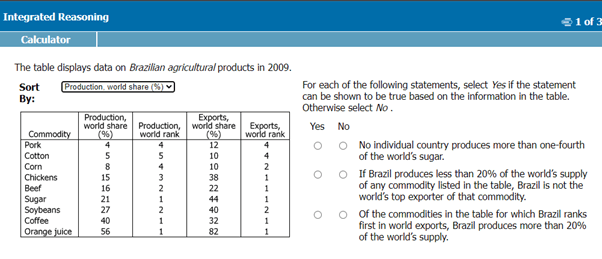
Source: https://www.mba.com/service/samples/sample-764
As we can see in this GMAT Integrated Reasoning sample question, the table presented has a brief contextualizing sentence, and is sortable by column. To the right are the three sub-questions that comprise this single IR question.
As stated, it’s possible to rearrange the table by column. This makes it easier to quickly find the data you need to answer a question. For instance, in the first statement, it is necessary to find out what percentage of the world’s sugar Brazil produces. It would therefore make sense to sort as in the example image above (by ‘production, world share (%)’).
Tips for Answering Table Analysis Questions
- The ability to sort by column is there for a reason. The questions will quickly reveal which columns you need to sort by, so read them over carefully and then sort the columns accordingly. This will help you answer the questions more quickly and efficiently.
- Be sure that you’re aware of which units of measurements are being used, and how you’ll use them to make any necessary calculations.
- Take note of the various column headings, what they mean in the broader context of the table, and how you might use them to quickly and accurately answer the questions.
- Briefly skim the whole table and each column within it, and try to figure out how each one relates to the broader story the table is trying to tell. Note that it is not necessary to intensively read through the whole table, merely to have a general idea of its content.
- Carefully read the statements and figure out the information you need to answer them. Note down the necessary calculations you’ll need to make.
- There are no partial scores in the IR section, so don’t leave any questions unanswered. This may sound obvious, but it’s easy to rush and leave one unfinished. Because there are no partial scores, it doesn’t matter if you answer two correctly and leave one undone – 2/3 is a 0!
- Try to figure out the relationship between the columns and the overall table. This will help you sort them quickly and efficiently.
GMAT Integrated Reasoning Questions: Multi-Source Analysis
Multi-Source Analysis questions present you with a multi-tabbed document (a bit like an internet browser with multiple tabs), and a set of questions on the other half of the screen. You can switch freely between the various tabs.
The tabs may have text, or they may have data presented in graphic form (tables, charts etc.). The questions may be multiple choice, or they may be in dichotomous yes/no form.
Sample Multi-Source Analysis Question
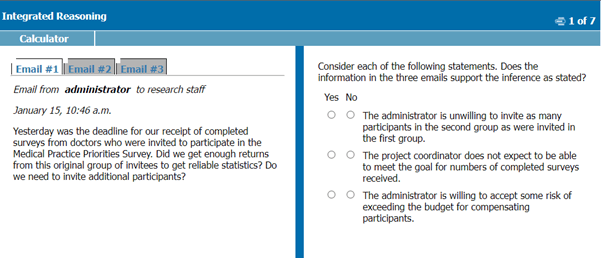
Source: https://www.mba.com/service/samples/sample-803-03#
In this GMAT Integrated Reasoning question example, the information is separated into three tabs that represent different emails. The questions will generally give an indication as to which tabs you’ll need to check in order to find the information you need. For instance, the first question refers to the ‘first’ and ‘second’ groups, meaning emails #1 and #2. It’s therefore a good idea to check out the questions before trying to fully digest the data shown on each tab.
Tips for Answering Multi-Source Analysis Questions
- Carefully go over the questions before you dive into the various tabs. The questions help to give the tabs context and will focus you on the information that you need to find.
- Don’t just scan the content for the information you need to answer your current question; skim it and try to mentally summarize the key takeaway from each tab. This will help you answer the other questions more quickly and easily.
- In a similar vein, don’t dismiss information that’s not immediately relevant. Try to remember every fact and figure you come across, so that you can recall it for later use.
- Use your scratchpad to note down the gist of each tab. This will be faster than referring back to each tab later, and will help ensure that you have enough time overall.
- When skimming for information, don’t stop the second you think you find what you need in order to answer the question. It could be that you’re missing out on further important information that may reframe what you’ve read and change your answer.
Two-Part Analysis Questions
A two-part analysis question presents you with a brief problem or situation and asks that you choose two answers related to the problem. The two answers are somehow interconnected, and are presented in a table format with a column for each answer. The answers must not contradict each other.
There are usually 5-6 potential answer choices. Two-part analysis questions can be further sub-divided into the following categories:
- ‘Follow the rules’ logic questions
- Quantitative analysis
- Critical reasoning
Sample Two-Part Analysis Question
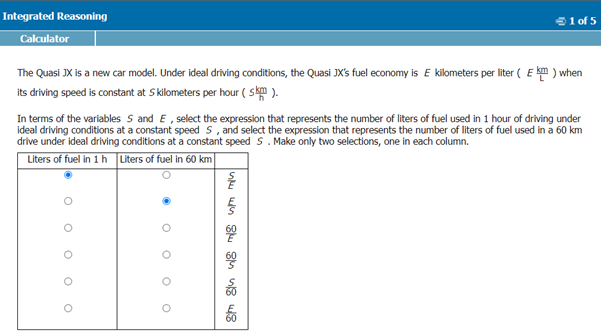
Source: https://www.mba.com/service/samples/sample-157
In the example, we can see the introductory passage that explains the nature of the problem and provides the data we need to solve it. It’s then necessary to choose one answer in the first column and one in the second. Note that the two answers use the same pool of answers for this.
Tips for Answering Two-Part-Analysis Questions
- As noted, there are three types of potential questions in this section. Try to figure out the type of question as quickly as possible, so you can begin to formulate your strategy for answering it.
- If you can see numbers, figures or algebraic, you can conclude you’re dealing with a quant-type question. Conversely, if you can see terms like ‘infer’, ‘assume’ or ‘conclude’ then you’re dealing with a critical reasoning one.
- Look at the questions closely before answering – don’t just rely upon the column headings, as they don’t tell the whole story.
- Try to figure out if the two tasks are interlinked. Quite often, the answer for one provides or hints at the answer for another, making your job easier in answering it.
- If it is the case that the tasks are interrelated, adopt an approach (such as a simultaneous equation) that will allow you to calculate both answers at once.
- If, on the other hand, the two tasks are independent of one another, focus on one first. The answer of one may still provide some insight into the answer of the other.
- Determine your strategy for answering the question quickly and early. You will not apply the same reasoning to a quant question as to a logic one, for example.
- Don’t try to use personal knowledge of the subject being discussed in order to answer it. Anything not found within the text or the table – including your personal knowledge – is not needed to answer the question, and it’s a mistake to attempt to use such knowledge to do so.
- It’s sometimes possible that the same answer can be used for both tasks. Try to figure out if this is the case before answering, in order to speed up your calculations.
- Make sure to carefully read the contextualizing information and make notes on your scratchpad of the salient points therein.
- In a ‘follow the rules’ logic question, quickly identify and make note of the rules in the passage.
- For critical reasoning questions, identify the premise and conclusions made in the passage. This will help you more quickly answer the questions.
GMAT Integrated Reasoning Questions: General Advice
Though it’s not possible to know what GMAT Integrated Reasoning question types there are going to be when you take the test, it’s nevertheless possible to keep a few things in mind in order to ensure that you’re as prepared as possible.
Practice, Practice, Practice!
There really is truth in the old adage “practice makes perfect”, and nowhere is this more exemplified than in the IR section of the GMAT. The section is designed to test candidates’ abilities to manage, categorize and sift through vast amounts of data, and can be very overwhelming without a solid approach. The best way of getting used to the overwhelming amounts of data is to take as many practice tests as possible, so that you develop a feel for the type of data that is relevant and irrelevant.
Work on your Graphics Interpretation Abilities
Graphics like scatter graphs and Venn diagrams can throw you off if you’re not familiar with them. That’s why it’s important that you expose yourself to them as much as possible, both in practice tests and in real-world examples found in financial publications.
Get Used to the Onscreen Calculator
Not everyone frequently uses a computer calculator, and so the functions may not be familiar if you’re one of these people. It’s important to get used to it so you don’t waste time in the actual test trying to figure out which buttons do what.
The best way of doing this is with plenty of GMAT Integrated Reasoning sample questions, which will allow you to use the calculator exactly as it will appear in the test. With a little practice, you’ll soon be using the calculator quickly and easily. Remember, though, the calculator will only be available in this section and not in the Quant part of the GMAT.
Know When To Cut Your Losses and Move On
On occasion, you’ll come across a question that you simply cannot answer with any certainty. If this is the case, don’t get hung up on it to the detriment of other questions. Take your best guess, and move on. You can always come back to it if you have any time left over at the end.
Work on your Time Management Skills
When you’re doing GMAT Integrated Reasoning example questions, make sure that you’re timing yourself and that you’re working on answering them as quickly (and accurately) as possible. Remember that you only have 30 minutes to answer all questions, and that despite there ostensibly being 12 questions, in practice there are usually many more. It’s critical, then, that you can answer them efficiently and quickly.
Conclusion
Though the Integrated Reasoning section of the GMAT may seem very daunting upon first glance, the fact is that by understanding the type of GMAT Integrated Reasoning questions that will pop up you can properly prepare for them, and thus increase your chances of getting the score that you want. And remember: practice really does make perfect! Get in as many GMAT Integrated Reasoning question samples as you can prior to your test. When you finally walk into that exam room, you’ll be so well practiced that answering the questions will be second nature!
